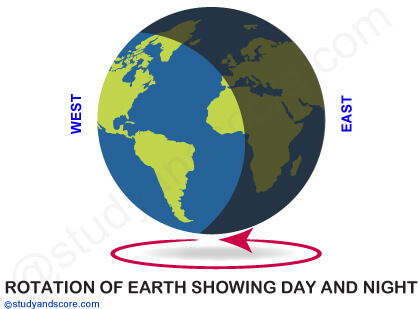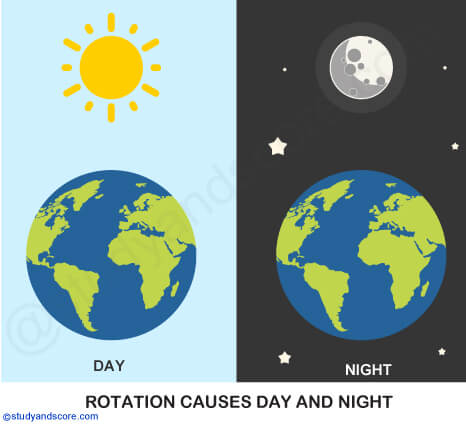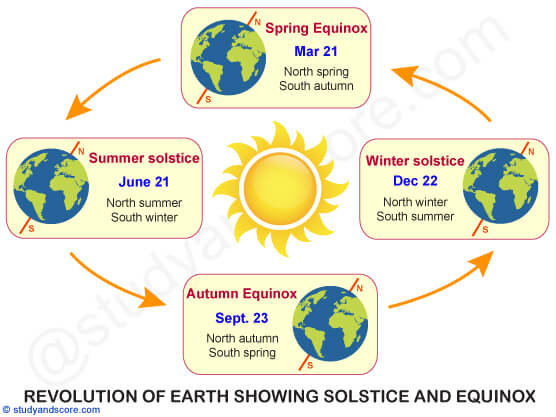All the planets in the solar system have three motions. They are rotating on their respective axis. They are revolving around the Sun. Along with the Sun planets are revolving around the Milky Way Galaxy. Now we shall study about these movements with special reference to our planet Earth. Earth, like other planets of the solar system rotates on its own axis and revolves around the Sun. Let us compare the rotation of a toy top with that of the earth.
The top rotates on the nail pierced through it. When the top rotates, the nail acts as its axis, which is perpendicular to the ground. But the axis of the earth is not perpendicular, it is inclined 23 ½° to the vertical. In such inclined position, the earth takes 24 hours to complete one rotation.
While the earth rotates on its axis, there are two constant points- one on the north called as the North Pole and the other on the south called as South Pole. An imaginary line which connects the North Pole and the South Pole through the center of the earth is called as the axis.

Day and night are caused due to the rotation of the earth. During rotation, while the earth moves around its axis, only half the portion of it receives sun’s rays and therefore, it appears bright, the other half remains in darkness. In other words that half portion of the earth which is lit by sun rays experiences day and the other half experiences night.
In the process of rotation the portion lit by sun rays gradually goes into light. This is the reason at day and night occurs alternately. Earth takes about 23 hours, 56 minutes and 4.09 seconds to complete one rotation.

The Sun rises in the east and sets in the west. Similarly, moon and stars also rise in the east and set in the west. All these happen due to the rotation of the earth from west to east. For example, while travelling in a train we observed that the trees appear to move in the direction opposite to our own direction of travel. Whereas the train in which we travel appear to be stationary. Similarly the Sun rises in the east and sets in the west because the earth rotates from west to east. It appears to us that the earth is stationary. But actually it is quite opposite (i.e. Earth and train are not stationary)
The earth also revolves around the Sun while rotating on its 23 ½° inclined axis. This movement is called revolution. This inclination remains same throughout its revolving period. This inclination produces seasons over the surface of the earth.
When the South Pole is inclined towards the Sun,
Similarly, when the North Pole is inclined towards the Sun,

Thus, the quantum of light energy received by both the Hemispheres of the earth varies according to their positions. The seasons are produced on the earth due the rotation of earth along the inclined axis while revolving around the Sun. Based on the prevailing temperature of the earth surface, an year is divided into four seasons namely summer, autumn, winter and spring.
Distance between the Earth and the sun is not constant as the earth’s orbital path is elliptical in shape. Sometimes the earth occupies farthest position from the sun and at other times closest to the sun. The farthest position of the earth from the sun is known as aphelion and the closest position is known as perihelion
During the course of its revolution round the sun, the earth occupies various positions. We know that north and South Pole are alternately inclined towards the sun. It means that the rays of the sun strike vertically overhead on different latitudes when earth is in various positions.
Spring: On March 21, the rays of the sun fall vertically on the equator. Both the North and South Poles are equidistant from the Sun. At this juncture both the hemispheres are facing the Sun and so days and nights are equal. During this period of three months namely March, April and May spring season prevails in the Northern Hemisphere. At the same time the South Pole experiences autumn.
Summer: On June 21, the rays of the sun fall vertically on Tropic of Cancer in the Northern Hemisphere. The rays of the Sun fall vertically on the tropic of cancer. Every place in the Northern Hemisphere receives sunlight for more than twelve hours. The Northern hemisphere experiences long days and short nights. This part of the year is hot. So it is called summer season.
The Northern Hemisphere experiences the summer season for three months namely June, July and August. During these three months the South Pole is inclined away from the Sun and hence experiences the winter season.

Autumn: On September 23, the rays of the sun fall vertically again on the equator. Both the north and the south poles are equidistant from the Sun. At this juncture both the hemispheres are facing the Sun equally and so days and nights are equal. The autumn season prevails in the Northern Hemisphere for three months namely September, October and November. At the same time the South Pole experiences spring.
Winter: On December 22, the rays of the sun fall vertically on the Tropic of Capricorn in the southern hemisphere. Every place in the Southern Hemisphere receives Sunlight for more than twelve hours. At the same time the North Pole is inclined away from the Sun and North Pole is in total darkness.
Other places in the Northern Hemisphere experience long nights and short days. This time of the year is called winter season in the Northern Hemisphere. The Northern Hemisphere experiences the winter for three months namely December, January, and February. At the same time the South Pole experiences summer.
It is important to note that as the sun appears vertically overhead at noon on the equator on March 21 and September, the lengths of day and nights are equal all over the world on these two days. Hence these two days are called equinoxes.
In India it is assumed that the Sun migrates
Both these days are celebrated in India as festivals.
Hope you have liked this post.
Please share it with your friends through below links.
All the very best from Team Studyandscore
“Study well, Score more…”
- Share with your friends! -
Login to post your comment here...
- or with social Account -